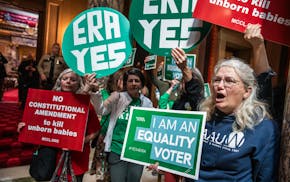Last year's bridge collapse on the edge of downtown Minneapolis is still reverberating in the southern suburbs.
A new urgency to fix and replace decrepit bridges is a big reason why, even though there's a lot more money available for transportation, very little of it is going into plans for new or faster highways to handle the growth that's on the way, experts say.
And that is causing unhappiness this month among leaders in both Scott and Dakota counties as the counties weigh the impact of the Metropolitan Council's plan for what to do with the money it has.
So little is available for new lanes that the total tab for the category labeled "improvements" all across the seven-county metro area, $26 million, "is less than the cost of a single new interchange" in an urbanized area such as Lakeville, said Lisa Freese, Scott County's transportation program manager.
"Absolute stupidity," said Bob Vogel, chairman of the Scott County Board. "All this money into the transit blob, yet we can't improve roads outside the beltway because there's no money left."
Both counties are pointing out that vast new areas of development are planned on the metro fringe. From now to 2030, the period the plan covers, at least 63 percent of the region's growth is expected to take place beyond the 494/694 beltway, according to Scott County's letter to the regional planning agency. Yet "the focus of all of [the council's] efforts and strategies are almost 100 percent within [that] beltway."
Of particular concern in Scott, which is getting far less help than Dakota in the near future:
• There's no sign of interest in moving ahead on a new bridge over the Minnesota River, even though the Hwy. 169 bridge is being overwhelmed at rush hour. In fact, there's a "step backwards" as the plans decline even to spend money to set aside land for a future bridge.
• Messages are mixed on whether to consider Hwy. 169 as the site for a new transitway such as bus rapid transit, a light-rail-like system relying on frequent bus service. One map included with the council's plan seems to hint that it's a possibility, but in other respects 169 doesn't seem to be treated like other similar corridors around the metro area.
• In a sign of "disconnect" between plans for development and plans for roads, there appears to be no interest in ever providing major new highways, such as one that might run east to west across the southern metro area.
Dakota County's reaction to the draft plan is a bit less anguished than Scott's, and for good reason, said Lezlie Vermillion, Scott County's director of public works: "Dakota is getting some major investments," including two new bus rapid transit projects being fast-tracked on Cedar Avenue and on Interstate 35W, thanks to a $133 million federal windfall.
But Dakota has its critiques as well. Among them: Although Met Council guidelines call for major highways to be spaced 3 to 6 miles apart in areas that are rapidly suburbanizing, there's a 13-mile gap in north-south highways between I-35W and Hwy. 52 in southern Dakota County.
Although they understand that money is short, officials in both counties say, they don't get why there seems to be little interest in even defining corridors that will be needed in the future and beginning to lay down markers now so that it doesn't become more expensive years later.
Both counties express concern about a lack of interest in pursuing commuter rail through their territory. Scott County is unhappy about state legislation -- obtained by constituents in Dakota and Hennepin counties, concerned about safety and other issues -- forbidding the council from even mentioning a possible Dan Patch line from Northfield to Minneapolis, via Savage. And Dakota's letter notes that the Red Rock line from Hastings, which faces no such prohibition, is not included even as a subject of study.
A big reason for the lack of big plans, both counties acknowledge, is the requirement that agencies such as the council create plans that are "fiscally constrained." That means not claiming to be planning projects that bureaucrats have no real reason to think will ever be funded, given existing money streams.
With construction costs rising and gas-tax proceeds falling, the council's plan is to concentrate on smaller congestion-easing efforts such as the small change to Hwy. 100 in St. Louis Park that produced major gains in speed at modest cost.
At the same time, some of the fast-growth projections that both counties refer to beyond the beltways are being reevaluated, Met Council officials say, as growth in places like Scott County falls off dramatically from what it was earlier this decade.
And there are bright spots even within the draft plan, the counties say. Among them, said Freese, of Scott County: "They do want to double the number of express buses, which is probably the area that benefits us the most."
David Peterson • 952-882-9023

Change at the top looms in high school softball rankings

House Democrats push to put protections for equal rights, abortion on Minnesota's ballot in 2026
Suit: Supervisor at conservation group altered photos of co-workers to appear sexual
Three killed, at least three injured in alcohol-involved head-on Cass County crash

